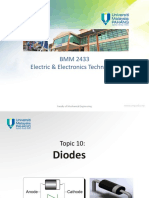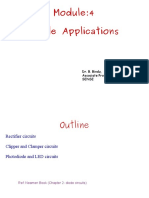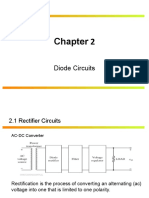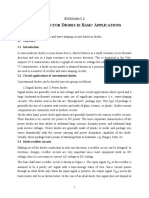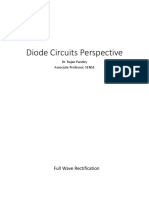0% found this document useful (0 votes)
293 views54 pagesDiode Circuit Analysis Guide
This document provides an overview of diode applications including solving diode circuits using different methods such as the ideal equivalent circuit, simplified equivalent circuit, and characteristic curve analysis. It discusses load line analysis to determine the operating point of a diode in a given circuit. It also covers half-wave and full-wave rectification circuits including their ideal and realistic output voltages. Additional topics include diode clippers and clampers, explaining how they work and how DC biasing can be applied. Zener diodes are introduced as having similar forward bias characteristics as regular diodes but operating in reverse bias at the Zener voltage to act as voltage regulators. Examples and problems are provided to help understand these concepts.
Uploaded by
Naruto DragneelCopyright
© © All Rights Reserved
We take content rights seriously. If you suspect this is your content, claim it here.
Available Formats
Download as PPTX, PDF, TXT or read online on Scribd
0% found this document useful (0 votes)
293 views54 pagesDiode Circuit Analysis Guide
This document provides an overview of diode applications including solving diode circuits using different methods such as the ideal equivalent circuit, simplified equivalent circuit, and characteristic curve analysis. It discusses load line analysis to determine the operating point of a diode in a given circuit. It also covers half-wave and full-wave rectification circuits including their ideal and realistic output voltages. Additional topics include diode clippers and clampers, explaining how they work and how DC biasing can be applied. Zener diodes are introduced as having similar forward bias characteristics as regular diodes but operating in reverse bias at the Zener voltage to act as voltage regulators. Examples and problems are provided to help understand these concepts.
Uploaded by
Naruto DragneelCopyright
© © All Rights Reserved
We take content rights seriously. If you suspect this is your content, claim it here.
Available Formats
Download as PPTX, PDF, TXT or read online on Scribd
/ 54











